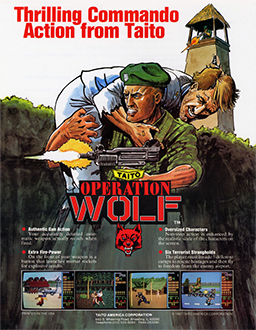Operation Wolf
This article has multiple issues. Please help improve it or discuss these issues on the talk page. (Learn how and when to remove these messages)
|
| Operation Wolf | |
|---|---|
 Operation Wolf arcade flyer. | |
| Developer(s) | Taito |
| Publisher(s) | Taito |
| Platform(s) | Arcade, Nintendo Entertainment System, Sega Master System, ZX Spectrum, MSX, Commodore 64, Amstrad CPC, Amiga, Atari ST |
| Release | Arcade Template:Vgy NES Template:Vgy SMS Template:Vgy |
| Genre(s) | Shooting gallery |
| Mode(s) | Single-player |
Operation Wolf (オペレーションウルフ, Operēshon Urufu) is a one-player shooter video game made by Taito in Template:Vgy.[1] It spawned three sequels: Operation Thunderbolt (Template:Vgy), Operation Wolf 3 (Template:Vgy) and Operation Tiger (Template:Vgy).
Description
The player takes the role of a Special Forces Operative. The object of the game is to rescue the five hostages in the concentration camp. The game is divided into six stages: Communication Setup, Jungle, Village, Powder Magazine, Concentration Camp, and Airport. Completion of each stage advances the story. For example, upon completing the Jungle stage, an enemy leader is interrogated and the location of the enemy's concentration camp is found. This was one of the first shooter games to feature a storyline, and it had some similarities to real special operations missions.
Gameplay
The game is controlled with a fixed swivel mounted light gun controller attached to the cabinet, with force feedback to simulate recoil.[2] In order to complete each stage, the player must shoot as many soldiers, tanks, jeeps, choppers, and boats as the game requires. Soldiers can throw hand grenades and knives, and vehicles can shoot missiles and launch rockets. The player's ammunition and grenades are limited, but can be stocked up by shooting barrels and crates or by shooting animals such as chickens and pigs. Occasionally a high-powered machine gun power-up appears, allowing the player's gun to have unlimited ammo and an increased rate of fire for 10 seconds. Completing the Powder Magazine stage fills the player's ammunition and grenade supplies to maximum.
The hostages do not appear until the Concentration Camp stage. Here, the player must protect them from harm as they run to safety. During the Airport stage, the player must fend off enemy attacks as the hostages run toward the open hatch of an airplane taxiing along a runway. The player is awarded a bonus based on the number of hostages that successfully board the plane.
The player has a damage bar that increases each time he is hit. The damage bar also increases if a civilian or hostage is shot. Energy boost items randomly appear which, if shot, decrease damage by five points. In addition, the player recovers a large amount of damage after completing the Village stage, and a small amount after completing each of the others. If the damage bar fills completely or the player runs out of ammunition and grenades, the game ends.
Home conversions
One of the most ported arcade games of all time, it has seen releases on everything from the Amstrad CPC to DOS, as well as the NES, the Sega Master System, the FM Towns and the PC Engine. Most of these ports lack any kind of light gun support (with the notable exceptions of the NES, Sega Master System, and the ZX Spectrum, which featured Magnum Light Phaser support) and must be played with a keyboard or a controller. The box for the Master System version features promotional art from Operation Thunderbolt.
In Template:Vgy, Operation Wolf was released on the Xbox, PlayStation 2, and Microsoft Windows as part of Taito Legends; however, light gun support is unavailable. On February 4, 2008, the NES version of Operation Wolf was released on the North American Wii Virtual Console. Whereas the NES version allowed NES Zapper support, the VC re-release does not feature any kind of light gun support (including the Wii Remote's pointer functions), making the game only playable with the standard controller mode.
Reception
| Publication | Score |
|---|---|
| Crash | 91%[4] |
| Computer and Video Games | 92%[6] |
| Sinclair User | 90%[5] |
| Your Sinclair | 9/10[3] |
| The Games Machine | 89%[7] |
| ACE | 894/1000[8] |
| Publication | Award |
|---|---|
| Crash | Crash Smash |
| C+VG | CVG Hit |
The game won several awards at the Golden Joystick Awards, including Best 8-bit Game Overall, and Best 16-bit Coin-op Conversion.[9] In the Spectrum sales charts, it was number two, behind RoboCop, which was number one every month for most of the year.[10] It was also voted number 26 in the Your Sinclair Readers' Top 100 Games of All Time.[11]
References
- ^ "Operation Wolf". The International Arcade Museum. Retrieved 3 Oct 2013.
- ^ spydersvenom. "Operation Wolf (arcade)". Gaming History 101. Retrieved 3 Oct 2013.
- ^ http://www.ysrnry.co.uk/articles/operationwolf.htm
- ^ http://www.worldofspectrum.org/showmag.cgi?mag=Crash/Issue59/Pages/Crash5900019.jpg
- ^ http://www.worldofspectrum.org/showmag.cgi?mag=SinclairUser/Issue080/Pages/SinclairUser08000027.jpg
- ^ http://www.worldofspectrum.org/showmag.cgi?mag=C+VG/Issue086/Pages/CVG08600025.jpg
- ^ http://www.worldofspectrum.org/showmag.cgi?mag=TheGamesMachine/Issue13/Pages/TheGamesMachine1300059.jpg
- ^ http://www.worldofspectrum.org/showmag.cgi?mag=ACE/Issue15/Pages/ACE1500042.jpg
- ^ http://www.worldofspectrum.org/showmag.cgi?mag=C+VG/Issue092/Pages/CVG09200062.jpg
- ^ http://ysrnry.co.uk/ys40.htm
- ^ "Readers' Top 100 Games of All Time". Your Sinclair. September 1993.
External links
- Operation Wolf at the Killer List of Videogames
- Operation Wolf at MobyGames
- Operation Wolf at SpectrumComputing.co.uk
- Operation Wolf (video game) on the Amiga at The Hall of Light (HOL)
- Articles needing cleanup from July 2008
- 1987 video games
- Amiga games
- Amstrad CPC games
- Arcade games
- Atari ST games
- Commodore 64 games
- DOS games
- Light gun games
- MSX games
- Nintendo Entertainment System games
- Ocean Software games
- Rail shooters
- Sega Master System games
- Taito games
- TurboGrafx-16 games
- Virtual Console games
- ZX Spectrum games

